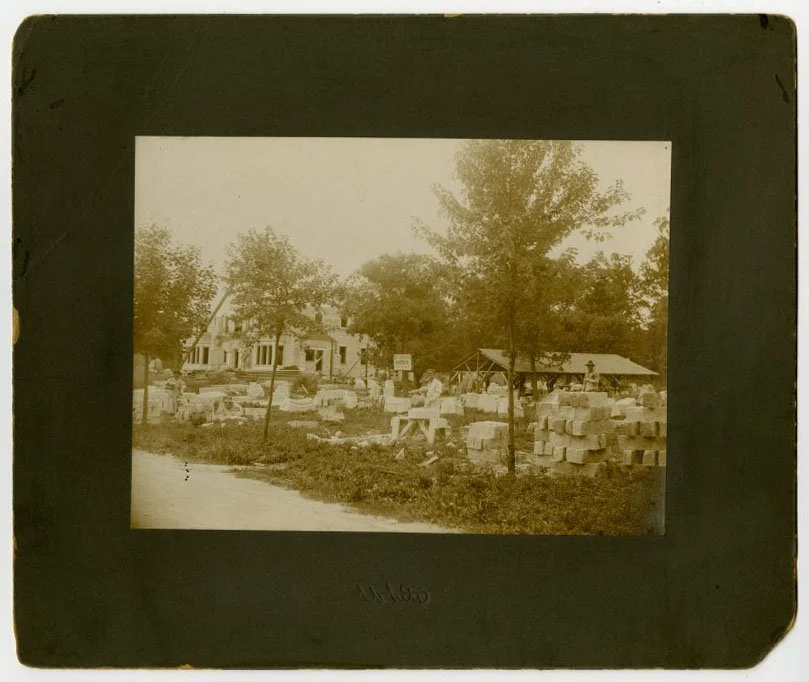“The Stone Cottage” on Minnetrista Boulevard
The Mary Lincoln cottage in the fall. You’ll find this structure at the very end of Minnetrista Boulevard, right at the intersection with North Wheeling Avenue.
What is the power of a name?
Nebosham under construction, lose stones in the yard. Minnetrista Heritage Collection, 11308-11311.
Visitors to our museum frequently have questions about the names around campus: what is a “Minnetrista,” why is the E.B. and Bertha Ball Center also called Nebosham, where do the names Oakhurst and Maplewood come from? Unlike those properties, the smallest of the historic houses on the Boulevard - the Mary Lincoln Cottage – has always seemed to have the most straightforward “name story.” Mary Lincoln, a Ball family cousin, lived in the house for many decades and its name now honors her memory.
History, however, is frequently a beautiful unfinished story. As new information comes to light, its chapters rewrite themselves and evolve. And as it turns out, even this unassuming building still has some secrets to share.
The early history of this house has long been shrouded in some mystery. We knew the house existed by 1907 but not exactly when it was first built, or by whom. Ball family legend recorded that the cottage may have been built with leftover stone from Nebosham, the home of E.B. and Bertha Ball, built between 1905 and 1907.
Historical records show that Mary Lincoln and her parents were in the house by 1907, so we’ve long assumed the structure was built by the Ball brothers for their aunt, uncle, and cousin. However, the recent rediscovery of a single newspaper article has forced us to rethink all these assumptions.
“Handsome Homes of Muncie, No. 13,” The Star Press, May 13, 1903.
In 1903, Muncie’s Star Press (still being published today!) ran a series of small profiles called “Handsome Houses of Muncie.” To our surprise, Number 13 is the Mary Lincoln Cottage! The article caption refers to the house as “the stone cottage” and indicates it was built in the summer of 1902 by the Fort Wayne architecture firm Mahurin & Wing. This tells us that the house was built several years earlier than we thought by the prominent Indiana architects who also designed Muncie’s Carnegie Library downtown, the main gates to Beech Grove Cemetery, and several of the other Ball family houses at Minnetrista! What most interested me, however, was the subtitle, which referred to the house as the “residence of Mrs. Martha Harvey.” Who was this?
As it turns out, the Ball brothers did not build the cottage for the Lincolns but rather for another extended family member.
Left to right: The Bingham sisters (Lucina, Maria, and Martha), Clarence Harvey, and Elvie Iona Harvey. Minnetrista Heritage Collection.
Mrs. Martha Harvey was also an aunt of the Ball brothers through their mother Maria Bingham Ball’s side of the family, the youngest of Maria’s five siblings. Shortly after the Ball brothers moved to Muncie and established their glass business here, Martha, her son Clarence and his wife Elvie followed them to the Hoosier state, settling in town in about 1889. Clarence worked as a foreman in a Ball glass factory. All evidence indicates the two families were close, the families of Minnetrista Boulevard were frequently in touch with their aunt. Following the unexpected deaths in 1892 of both their mother Maria and cousin Clarence (on the same day, no less!), the brothers seem to have committed to caring for their elderly aunt.
Martha Harvey on the porch of her house at 362 Ohio Avenue. Minnetrista Heritage Collection, 9873-9874.
Mary Lincoln later in life, working as a cashier for Ball Brothers. Minnetrista Heritage Collection, 9901-9910.
Following Clarence’s death, the Ball brothers paid off the mortgage for Martha and Elvie’s house on Ohio Avenue. By 1902 however, when Martha was in her early 70s, they seemed to have made the decision to move her even closer to them. Martha’s 1906 obituary confirms this, explaining that “during the latter years of her life, everything was done for her that would make the declining years of her life comfortable by her nephews, the Ball brothers. They built her the beautiful little stone cottage on Minnetrista Boulevard, which she occupied until the time of her death.” In tracing the Lincoln family in local records, it is clear that Isaac and Lucina Lincoln came to Muncie for Martha’s funeral and then soon after made the decision to move permanently, coming to Muncie in 1906 with their adult daughter, Mary Lincoln.
So what is the power of a name? Referring to the stone cottage on the Boulevard as the “Mary Lincoln cottage” is not incorrect. Mary did live in that house longer than anyone, from the time she moved to Muncie in 1906 until she passed away in 1950. Highlighting her in this way, however, erases the life and story of the original inhabitants for whom the Ball family actually built the home. Should Martha Harvey be represented in the cottage’s history and name? Should the entire Bingham family, the three sisters who tied these relatives together through familial bonds and affection? What is the power and purpose of a name?







